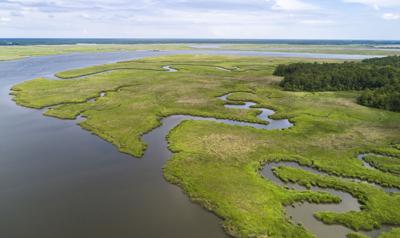Charleston’s drinking water utility will soon be compelled to comply with America’s first drinking water standards for “forever chemicals.”
Mark Cline, Charleston Water System’s chief executive officer, said the water utility will meet those new rules. But it’s not going to be cheap.
“In my view, and I’ve been doing this for 40 years, this is the most expensive rule EPA has ever put in place for drinking water,” Cline said.
He estimates that installing the treatment technology to meet the new guidelines will cost “at least” $130 million in capital costs and $10 million to $12 million in annual operating costs for the Water System.
The U.S. Environmental Protection Agency announced the long-awaited regulations April 10, estimating that complying with the rules nationwide will cost $1.5 billion annually. That’s essentially a break-even point, as the federal agency also estimates the new rules will result in savings of $1.5 billion per year from lower cancer rates, fewer heart issues and reduced birth problems.
The pollutants go under the scientific name per- and polyfluoroalkyl substances (PFAS), which pose health risks at even small levels of exposure. PFAS is a massive chemical family with thousands of member compounds, some of which can take hundreds of years to break down — hence their nickname “forever chemicals.”
Charleston Water System serves about 125,600 customers in the region. Its most recent testing for PFAS showed that the utility is already in compliance with new standards for the compound PFOA, a known human carcinogen. But levels of the compound PFOS, a possible carcinogen, were tested at 5.56 parts per trillion, which is above the new health standard of 4 ppt.
Charlestonians who want to avoid drinking elevated PFOS levels can decrease their exposure through table-top water filters.
PFAS have been linked to a laundry list of health issues. That includes, among other things, increased infertility, developmental problems, increased risk of certain cancers and hormonal issues. The EPA notes that ”research is still ongoing” and the precise health effects of PFAS can be difficult to tease out given the size of the chemical family and the multiple different routes of exposure.
The federal agency anticipates that these new guidelines will prevent PFAS exposure via water for about 100 million people, and significantly curtail PFAS-caused illnesses and deaths.
Maximum Contaminant Levels
*Above new EPA PFAS Maximum Contaminant Levels
| Compound | Final MCLG | Final MCL (enforceable levels) | CWS Testing (Dec. 2023) |
|---|---|---|---|
| PFOA | 0 | 4 parts per trillion | 3.77ppt |
| PFOS | 0 | 4ppt | 5.56ppt* |
| PFHxS | 10ppt | 10ppt | 0 |
| PFNA | 10ppt | 10ppt | 0.63ppt |
| HFPO-DA (commonly known as GenX Chemicals) | 10ppt | 10ppt | 3.22ppt |
| Mixtures containing two or more PFHxS, PFNA, HFPO-DA and PFBS | 1 (unitless) | 1 (unitless) | 0.6ppt |
The new regulations set drinking water limits for six of the most harmful PFAS varieties. The EPA set a deadline of 2029 for full compliance with the limitations, but utilities will have to start monitoring and publicly reporting levels in 2027.
Charleston Water System is in compliance with most of the maximum contaminant levels established by the EPA on April 10, although it will take time to hit the non-enforceable Maximum Contaminant Level Goals for PFOA and PFOS.
The utility has been voluntarily testing for dozens of PFAS compounds since 2017. The results are published on its website.
“While there is no doubt that these chemicals have a place and are important for certain industries and certain practices, there is also no doubt that these chemicals entering our environment in an uncontrolled manner are harmful to our families, harmful to our communities and harmful to our economy,” EPA Administrator Michael Regan said at an April 10 press conference.
To help offset the cost of the new regulations, the EPA also announced April 10 that nearly $1 billion dollars in federal infrastructure grants will be made available to help utilities in small and disadvantaged communities cover costs. South Carolina is set to receive a little more than $11 million of that money.
Those grants are coming from the Bipartisan Infrastructure Law of 2021, which includes a total of $9 billion to address PFAS in drinking water, and another $12 billion for general drinking water improvements. Cline said the Charleston Water System likely wouldn’t qualify for any federal grants, and at best could expect a low-interest loan from the federal government.
“There are other avenues that the board might decide to take if they wanted to pursue damages against the manufacturers that contaminated the environment with the PFAS,” Cline said.
A Charleston judge this year has approved two major settlements proposed by chemical manufacturers 3M Co., DuPont and two other companies after they were named as key defendants in a national class-action lawsuit involving a toxic PFAS-laced firefighting foam that leached into drinking water systems across the country. While the litigation is far from over, the early water contamination settlements will provide more than $13.5 billion for several hundred U.S. water utilities. A smaller settlement offer of $750 million from Tyco Fire Products was filed with the same judge this week and would be added to the pot if it is approved.
But Cline said the legal agreements come with strings attached.
“Part of the problem with that — especially the larger one, 3M — is that, to take a settlement, you have to give them a full release against any further claims,” he said. “And the amount of money that you get is a fraction of what the damages are.”
So what does all of this mean for water bills here in Charleston?
“I would hate to speculate, but I would say it would be in the order of maybe a 5 percent … rate increase or a series of increases of around 5 percent, something of that nature,” Cline said, caveating that the utility still needs to do more cost modeling.
“You have a lot of customers every single day, hundreds upon hundreds who can’t pay their bill and have their water cut,” Cline said. He added that, on average, about 1.5 percent of the utility’s customer base — or roughly 2,000 customers — has water service shut off each month due to non-payment issues. “You’re talking about adding to that financial strain.”
Susan Richardson is a professor at the University of South Carolina specializing in PFAS and other drinking water contaminants. She previously spent more than two decades as a research chemist at the EPA. She believes the agency rushed in approving the new maximum contaminant levels.
“Thank God EPA gave (utilities) five years instead of three years,” she said. “They usually give them three years to comply for all the other previous drinking water regulations.”
Richardson said she’s skeptical of the new regulations for a few reasons. First, she said that drinking water is only one PFAS exposure route, and it’s found in countless other commonly used products, like non-stick cookware and even lipstick. She also said that while PFAS have been linked to a number of health effects, even the EPA notes more research into the pollutants is necessary before making many firm health claims.
“So is it worth it? This is the question, right?” she said. “I like to have everything removed in my water possible. That’s the precautionary principle. Is it worth that rate increase? I don’t think the drinking water treatment plants are going to get enough help from EPA, or anybody, to fund all this. It’s going to go to the consumer.”
Eleven states, not including South Carolina, have already set drinking water guidelines for PFAS contamination, according to the advocacy groups Safer States. Nearly a decade ago, the EPA previously set a non-mandatory advisory level of 70 parts per trillion for PFOA and PFOS, two of the most prominent members of the PFAS family.











